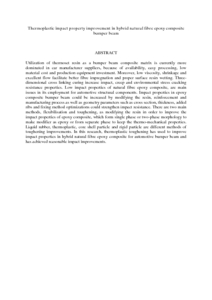Citation
Makinejad, Majid Davoodi and Salit, Mohd Sapuan and Ali, Aidy and Ahmad, Desa and Abdan, Khalina
(2010)
Thermoplastic impact property improvement in hybrid natural fibre epoxy composite bumper beam.
IOP Conference Series: Materials Science and Engineering, 11 (1).
ISSN 1757-899X
Abstract
Utilization of thermoset resin as a bumper beam composite matrix is currently more dominated in car manufacturer suppliers, because of availability, easy processing, low material cost and production equipment investment. Moreover, low viscosity, shrinkage and excellent flow facilitate better fibre impregnation and proper surface resin wetting. Three-dimensional cross linking curing increase impact, creep and environmental stress cracking resistance properties. Low impact properties of natural fibre epoxy composite, are main issues in its employment for automotive structural components. Impact properties in epoxy composite bumper beam could be increased by modifying the resin, reinforcement and manufacturing process as well as geometry parameters such as cross section, thickness, added ribs and fixing method optimizations could strengthen impact resistance. There are two main methods, flexibilisation and toughening, as modifying the resin in order to improve the impact properties of epoxy composite, which form single phase or two-phase morphology to make modifier as epoxy or from separate phase to keep the thermo-mechanical properties. Liquid rubber, thermoplastic, core shell particle and rigid particle are different methods of toughening improvements. In this research, thermoplastic toughening has used to improve impact properties in hybrid natural fibre epoxy composite for automotive bumper beam and has achieved reasonable impact improvements.
Download File
![[img]](http://psasir.upm.edu.my/11922/1.hassmallThumbnailVersion/Thermoplastic%20impact%20property%20improvement%20in%20hybrid%20natural%20fibre%20epoxy%20composite%20bumper%20beam.pdf)  Preview |
|
PDF (Abstract)
Thermoplastic impact property improvement in hybrid natural fibre epoxy composite bumper beam.pdf
Download (83kB)
| Preview
|
|
Additional Metadata
Actions (login required)
 |
View Item |

